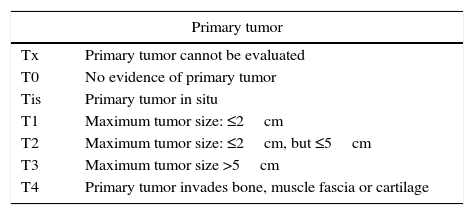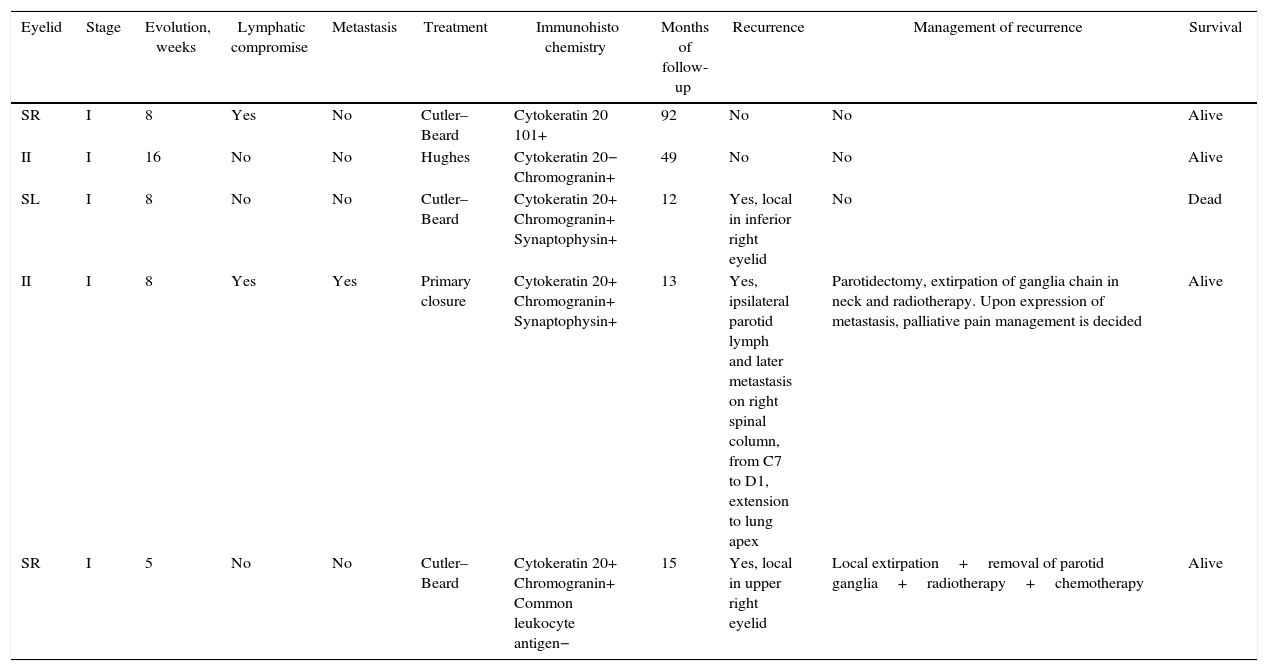Presentation of 5 clinical cases of Merkel cell carcinoma of the eyelid, highlighting the clinical, histopathological, management, and monitoring features. Review of related literature.
MethodsRetrospective review of clinical records and telephone interview of the 5 patients treated for Merkel cell carcinoma between 2006 and 2013, in the Orbit and Oculoplastic Department, Clinical Hospital of the University of Chile.
ResultsFive patients (2 men, 3 women); 79.2 years (range 64–94 years), with a mean onset of 10 weeks (range 5–16 weeks), tumor size reaching a mean of 2.5×2×2.1cm at the time of surgery. Described as a nodular mass, exophytic, solid, reddish colored. With no infiltrated lymph nodes or metastases in the first match. Staging as T2N0M0, after the first surgery with oncological criteria. Two lymph node recurrences detected during monitoring. Distant metastasis was found in one patient. The histopathological diagnosis was confirmed by immunohistochemical study of the biopsy. The surgical strategy was full excision, control of surgical margins in the intraoperative period, and eyelid reconstruction with Hughes flap, Cutler–Beard flap or primary closure, depending on the case.
ConclusionsEarly diagnosis, wide excision of the tumor with intraoperative control of clear margins with conventional or Mohs surgery, and proper eyelid reconstruction are adequate for a good survival in elderly patients with this eyelid tumor. The study of sentinel lymph node biopsy in primary intervention is recommended; with subsequent radiotherapy to decrease the recurrence and increase survival.
Estudio descriptivo de 5 casos clínicos de carcinoma de Merkel a nivel palpebral, destacando las características clínicas, histopatológicas, el manejo y seguimiento. Revisión de literatura asociada.
MétodosRevisión retrospectiva de fichas clínicas y entrevista telefónica a 5 pacientes tratados por carcinoma de células de Merkel entre los años 2006–2013, en el Departamento de Órbita y Oculoplástica del Hospital Clínico de la Universidad de Chile.
ResultadosCinco pacientes (2 hombres, 3 mujeres), de 79,2 años (rango 64–94 años), con una evolución de 10 semanas (rango 5–16 semanas), con un tamaño tumoral de 2,5×2×2,1cm en promedio al momento de la cirugía. Descritos como una masa nodular, exofítica, sólida, de color rojizo. Sin adenopatías sospechosas ni metástasis en el primer enfrentamiento. Tipificados como T2N0M0, tras la primera cirugía con criterios oncológicos. Se observó, durante el seguimiento, 2 recurrencias en nódulo linfoide. Encontramos metástasis a distancia en un paciente. El diagnóstico histopatológico se confirmó mediante biopsia corriente más inmunohistoquímica. La estrategia quirúrgica fue con extirpación completa, control de márgenes libres y reconstrucción palpebral con colgajo de Hughes, Cutler–Beard o cierre primario.
ConclusionesEl diagnóstico precoz, la extirpación amplia del tumor con control de márgenes libres intraoperatorio con cirugía convencional o técnica de Mohs y una adecuada reconstrucción palpebral permiten una supervivencia en pacientes añosos portadores de este tumor a nivel palpebral. Se recomienda el estudio de ganglio centinela y biopsia en la intervención primaria, junto a una radioterapia posterior, que disminuye la recurrencia y aumentaría la supervivencia.


















